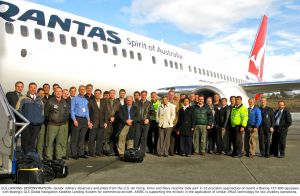
News
Boeing demonstrates “Landing System of the Future” for military observers, with ARINC support
 April 3, 2008, Annapolis, MD - Senior military officers and
pilots from the U.S. Air Force, Army and Navy recently got a glimpse of
the way many military aircraft will perform landings in the future.
April 3, 2008, Annapolis, MD - Senior military officers and
pilots from the U.S. Air Force, Army and Navy recently got a glimpse of
the way many military aircraft will perform landings in the future.
April 3, 2008 By Carey Fredericks

|
April 3, 2008, Annapolis, MD – Senior military officers and
pilots from the U.S. Air Force, Army and Navy recently got a glimpse of
the way many military aircraft will perform landings in the future,
using the latest satellite-based Precision Approach technology.
The two dozen military observers boarded a new Qantas Airways Boeing
Next-Generation 737-800 at Boeing Field January 31 and were treated to
a demonstration of Boeing’s advanced GLS Global Navigation Satellite
Landing System for commercial aircraft.
Like the military’s JPALS (Joint Precision Approach and Landing System)
currently under development, Boeing’s GLS system uses GPS satellite
technology to provide highly accurate and stable approach and landing
guidance under the worst visibility conditions.
During the flight, the Boeing 737 successfully completed fifteen GLS
approaches at five different airfields in the Seattle region. Boeing
chief pilot Doug Benjamin, who flew the plane, and several experienced
military pilots who rotated in the co-pilot seat, found GLS provided
extremely accurate guidance during approaches and landings.
The GLS demonstration flight was central to a 2-day informational event
hosted by Boeing at the specific request of the military. The event was
organized by ARINC
Engineering Services, LLC, for its long-time customer on the Land-Based
JPALS program, the Air Force Electronic Systems Center (ESC) at Hanscom
Air Force Base, Mass.
“On behalf of the Air Force, I would like to thank our hosts and the
teams from Boeing and ARINC who put this event together,” stated Air
Force 641st Electronic Systems Squadron Director Eric Lekberg. “This
vivid demonstration of today’s most advanced landing technology has
been extremely encouraging for the military teams working on similar
solutions.”
Boeing’s GLS solution works in combination with Ground-Based
Augmentation System (GBAS) ground stations, which enhance the
performance of GPS to provide the accuracy and integrity needed for
Precision Approach operations. In addition to the fixed ground stations
used for the January demonstration flight, attendees were also shown
examples of smaller GBAS ground stations in alternative form factors,
including a proof-of-concept man-portable JPALS system whose
development was recently coordinated by ARINC.
Qantas is an early adopter of GBAS technology and has been using the
Boeing GLS system in revenue service since 2006. Increasingly, airports
around the world are making plans to equip with GBAS ground stations
which require only a modest investment in airport infrastructure and
provide better performance and capability than the existing Instrument
Landing System.
ARINC Incorporated, a portfolio company of The Carlyle Group, provides
communications, engineering and integration solutions for commercial,
defense and government customers worldwide. Headquartered in
Annapolis, Maryland with regional offices in London and Singapore,
ARINC is ISO 9001:2000 certified. For more information go to www.arinc.com .